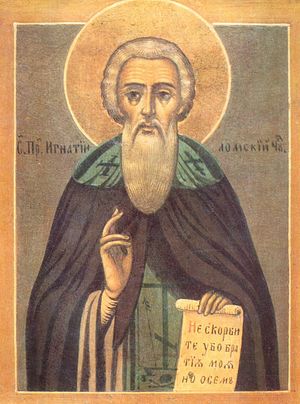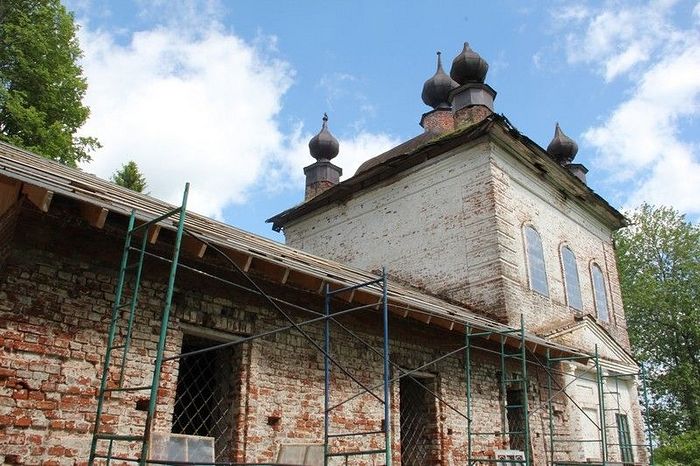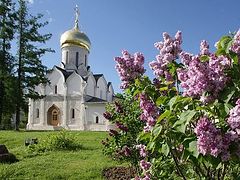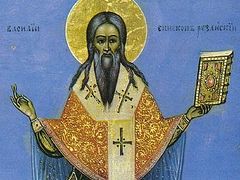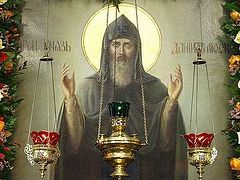In the early seventeenth century, the Yuzhsky volost1 of the Vologda uezd2 lived its usual life, as it would live before and after that time, just as dozens of other volosts and their inhabitants all over Russia lived in those remote times: People were born and died, plowed land and made their livings, quarreled and made up with each other, sometimes sinned and sometimes prayed and repented. And it seemed that in the monotonous routine of everyday events, the twists and turns of life and human suffering that befell every single peasant and commoner, there was nobody who stood out from the crowd. Even if a true man of prayer and fasting, unlike any of his friends and neighbors, had appeared in the flesh, his podvig [spiritual labor, feat, exploit] would have remained unnoticed…
That is why the holiness of this great saint was not revealed in his lifetime: He was in the world…, and the world knew him not (Jn. 1:10). During his lifetime he remained in obscurity, covering his Christian virtue with his old, threadbare monastic cassock and the fence of his peaceful monastery. At that time St. Ignatius Hermitage Monastery was just formally separated from the surrounding settlements by a token fence and not by a solid white stone wall. Time went on. And on one frosty day in January, Abbot Ignatius commended his soul into the hands of God. The neighboring villages’ residents didn’t gather for the funeral of the abbot—the brethren in their immediate monastic circle committed Elder Ignatius’s body to the earth. At the appointed time a priest would come and perform memorial services and read the prayers for the repose of the abbot over his grave. In time the memorial services were held more rarely, and eventually the name of the ever-memorable elder was included into the brethren’s list of the names of the departed to be prayed for; otherwise life at the monastery was going its usual way.
The hermitage monastery received new monks who sought the life of prayer. They didn’t know Abbot Ignatius personally, and even those who had known him for many years forgot much of what the holy elder had taught his spiritual children. The venerable man would speak very little about himself and with reluctance, and even his closest disciples could hardly say anything about the years of his childhood and youth…
At the beginning of the seventeenth century there were many orphans and afflicted in the Yuzhsky volost. The blind used to sit at the porch of the parish church on weekdays and holy days, the lame dragged themselves amid rows of stalls on market days, and orphans begged in the streets of large villages. And there was a disabled person in almost every house or izba [a peasant’s log hut in old Russia], and the household would take care of him for God’s sake. There were always lots of them—not only in that particular district, but in all districts and in all times. But now the Yuzhsky volost’s residents were granted an intercessor from above—somebody they had never thought of before. Through St. Ignatius’s prayers many of his fellow-villagers were healed: “Numerous miracles were wrought beside his holy relics as though from a continuously flowing stream. The blind recovered their sight, the deaf heard, the dumb spoke.” His Life doesn’t mention who was the first to turn to the reposed righteous man for help, but as soon as anybody invoked the name of the grace-filled elder, he first began to feel better and then was completely cured from his malady. So an incredibly long line of afflicted parishioners flocked to the monastery…
Now the monks of St. Ignatius Hermitage Monastery silently contemplated the remarkable transformation of their father-superior’s tomb that they had seen every day for many years. Neither the new abbot nor the brethren dared fence off his grave or forbid (by strict words or an unkind look) the pilgrims (who day after day covered greater distances) to come, take some earth from Elder Ignatius’s grave and bow down before his holy relics. As if in the state of spiritual paralysis, none of the monks thought of making a record of miraculous healings: “Though we did hear about his miracles, we didn’t bother to keep a record of them and simply forgot to do it. Thus many years passed.” Indeed a lot of time had elapsed and countless miracles had occurred through the venerable man’s intercessions before the brethren became aware of the need of making at least some notes for the future Life of the holy elder.
The brethren set about looking for people who could give them information. And since the crowd of pilgrims mainly consisted of peasants, and in the consciousness of the brethren the elder became above all the healer of sick peasants, the monastery’s chronicler turned to “elders, nobles and different ranks” of surrounding villages. But much to his regret they would answer: “We don’t know the country, or the city, or the village he came from. And we have no idea whether he was of noble or peasant birth, and whether he was wealthy or poor.” In a word, they learned absolutely nothing; there was no clue, no hint. Despite all of this, the monk whose obedience it was to write the elder’s Life kept searching among local residents, walking from village to village, knocking at the oak doors of large inner porches, talking with old-timers, asking elderly residents many questions about their youth in the hope that some reminiscences about Abbot Ignatius would come back to their memory. At last his patience was rewarded, and one of the long-time residents of the neighborhood told him the following:
“Old residents and our parents recounted that two monks had arrived to the site of the present-day monastery. Their names were Ignatius and Joachim.”
The ascetics who had come from an unknown land soon parted: Ignatius remained on the site of the hermitage monastery, while Joachim with the blessing of his spiritual father crossed the River Sara that ran a verst [an old Russian measure of length, c. 0.66 mile] away from the monastery. Here the anchorite built himself a cell for solitary prayer. But the monks maintained contact with him all the time: “They would visit each other and converse about spiritual things.”
The River Dorovitsa, a tributary of the Sara, flowed one verst south of St. Ignatius Monastery. There was a holy well on its bank, which according to tradition was dug by the ascetics.
“People go to this holy well, wash their faces and hands with its water, drink it, with the priest’s blessing fill their vessels with it and take it for home use. Their nearest and dearest sprinkle themselves with this water, drink it with prayer and reverence, and receive healing.” Alas, here the eloquence of the old-timers was exhausted: no resident of all the neighboring villages could tell the monk anything else. There is nothing to be done! With the blessing of the abbot the chronicler placed his stand at the entry to St. Ignatius’s shrine, questioning people going into and out of the monastery about what brought them there and what had been granted them through the venerable elder’s intercessions. And here are some of the accounts…
Hieromonk Theodosius recounted how he together with his son Gregory, a parish priest, became witnesses of the healing of a possessed man. A resident of one of the neighboring villages named Carpus “through the power of devil” fell into the habit of beating up his own mother in his chronic fits of anger and madness: …as a child that is weaned of his mother (Ps. 130:2). This lasted many years. One day, exhausted from the constant beating, the woman lost her patience and cursed her son… Truly, a mother’s prayer and blessing have a great power, yet the mother’s curse has enumerable baneful consequences! It is not without reason that Porfiry, nicknamed Iudushka (meaning “little Judas”), the prime villain in the novel The Golovlyov Family by the great Russian writer Michael Saltykov-Shchedrin (1826-1889), feared his mother Arina Petrovna’s curse most of all because it would entail incalculable miseries… These miseries soon fell upon Carpus: “The possessed man uttered nonsense, barked like a dog, and imitated the voices of other animals.”
In his wild frenzy the demoniac dashed around the yards and back streets of his village. The fellow villagers looked at him with disdain, believing that the debauchee had been rightly overtaken by divine retribution. Soon Carpus became “the talk of the village”, and mothers began to threaten their naughty children with him as if he were a bogeyman. At last his brother Ivan took pity on him. He remembered Carpus from childhood and understood more than anybody else that the outbursts of anger and blows were not an integral part of his (Carpus’s) immortal soul but the influence of the evil spirits on it. So John turned to Priest Gregory, imploring him to read “the Psalms of David and the prayers of exorcism” over the suffering man. Gregory agreed to help him, but asked his father to be present during exorcism.
Theodosius agreed. At the appointed time he entered the izba where were Gregory, Ivan and Carpus, who felt relatively calm after another prolonged and agonizing seizure. However, the arrival of Theodosius instantly enraged Carpus: “Incensed, he swore at Theodosius and hit him.” The hieromonk remained calm and patient, for he was well aware that the man’s tongue and hands were moved by demons who want the everlasting destruction of all of us.
In response to the aggression and threats Theodosius took the demoniac’s hand gently, helped him lie down on the bed and put an icon of the Holy Theotokos on his chest. When Theodosius started reading the psalms, and Gregory with Ivan knelt down before the possessed man’s bed, the demon uttered with his mouth: “The monk has not come alone—Ignatius of Lom is with him. Yet our kin are numerous.” The unclean spirit was obviously referring to other demons (who felt that they would soon be expelled from Carpus and tried their best to prevent his healing) as to “our kin”. The wretched spirits suggested to Carpus that Theodosius together with the venerable elder Ignatius, who was invisible to healthy people yet clearly visible to the eyes of the demoniac, had allegedly come in order to torture him to death and tear him to pieces. Utterly exhausted, Carpus began to toss in his bed, but Theodosius began to pray more fervently: “The hieromonk was singing the psalms with tears in his eyes.” A few moments later the demon at last surrendered, uttering: “The monk with Ignatius of Lom have overpowered us! All our kin have gone away...” On saying this Carpus quieted down and fell into a deep, sound sleep, after which he woke up absolutely healthy.
The chronicler was finishing writing the account of Theodosius with awe, when a tall, corpulent man who had heard the story came up to him. Judging by his clothes, bearing and appearance, the man seemed to be well provided for and have no physical ailments, but the love with which he had venerated the shrine of St. Ignatius a minute earlier indicated that he was listening to Theodosius’s account not out of idle curiosity. He identified himself as Semyon Yazykov, a merchant from the village of Sagozhi. Semyon recounted how his housemaid Xenia had been cured of a serious eye condition. The woman “didn’t see the world for many years, living in her master’s house.” Semyon “ministered to the sick maid for God’s sake” until the whole village of Sagozhi and the household of the kind-hearted merchant learned from stray guests that “Many people from faraway lands and villages receive healing beside St. Ignatius’s shrine.” Then Xenia begged the household to take her to the shrine of Ignatius the wonderworker. Semyon ordered his servants to escort the disabled woman to the Monastery of the All-Merciful Savior, which they did. At some point the servants left Xenia alone by St. Ignatius’s shrine.
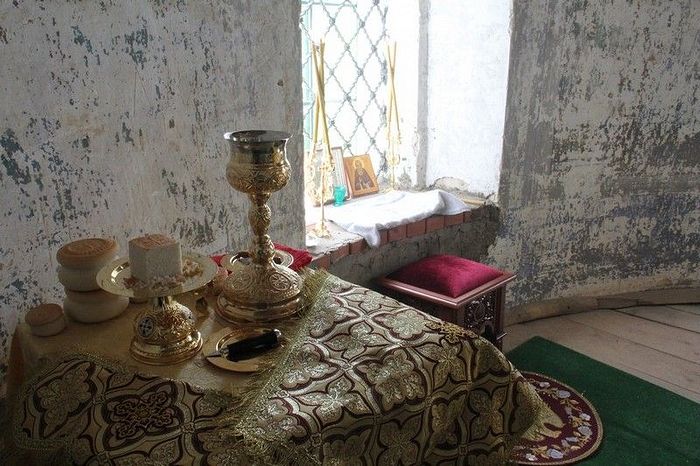 The Divine Liturgy at the Church of the Icon of the Savior not Made by Hands in the village of Spas-Lom, which is under restoration
The Divine Liturgy at the Church of the Icon of the Savior not Made by Hands in the village of Spas-Lom, which is under restoration Soon, as Xenia herself related, when the service of intercession commenced, she felt an inexpressible sorrow, her heart was wrung with sadness, and, worn out, with all her strength she cried to the reposed righteous man: “O holy father, I have heard many testimonies of your mercy for those who come from far and wide, for orphans and strangers! Don’t reject me, look down on my sorrow!” Her blind eyes shed floods of tears, creating an ornate pattern on the saint’s shrine. But there is an end to every sorrow, and every tear dries up. But this time the dried up tears revealed spots of light on the oak floor, the intricate contour of Slavonic letters on the shrine’s lid, the gazes of her astonished companions, and the uniform glitter of a lamp by the patronal icon of the Savior not Made by Hands to the unhappy woman.
Having learned about this miracle, Semyon made a point of visiting the St. Ignatius Hermitage Monastery regularly, venerating St. Ignatius’s relics, and praying for his and his household’s health.
The next day, on hearing that the monks were making a record of St. Ignatius’s miracles, new pilgrims flocked to the monastery with their testimonies of the elder’s miraculous help. Among them was a peasant named Nikita Yuriev from the khutor3 of Teleshino, the village Shishovka. Nikita told the chronicler that his wife Ulyania had suffered a misfortune. Before the incident she had been “a beautiful and sensible woman”, the man related wistfully, unable to understand why the situation had changed to the opposite so soon. “Very beautiful!... Many friends and neighbors marveled at her prudence and good housekeeping skills,” he emphasized, as if fearing that the listeners would suspect him of having little love for his wife. They suddenly met with misfortune on August 16 of the same year—the woman “fell sick and went out of her mind”. Ulyania “yelled and swore at her husband, ‘greeted’ any visitors with beatings, and in sudden unprovoked outbursts of fury she would start shattering their goods and chattel and breaking dishes.” One of these fits resulted in her utter exhaustion and nervious breakdown, her body became swollen, and she went completely insane. A lot of time elapsed; and one night Ulyania saw herself in a dream “with the brethren in the church of St. Ignatius Hermitage Monastery”. After that she began to feel better. Soon Nikita took his wife, “who was still insane”, to the monastery. It was there, by the venerable abbot’s shrine, to the sounds of the service of intercession, that Ulyania fully regained sanity.
Then a peasant named Savva Minin came to the monastery and recounted how from Pascha Sunday till the feast-day of Sts. Cosmas and Damian (November 1/14)—that is, for more than half a year, he had been stricken by a severe illness. “His lower limbs up to his knees became swollen, so that he could not take a single step unassisted.” The sufferer finally remembered the enumerable miracles wrought through the intercession of the holy Abbot Ignatius. He immediately promised that as soon as his legs held him again he would make a pilgrimage to his holy monastery and pray with tears to the venerable elder for the health of his soul and body. “Once he had made this vow, his illness abated and he was healed.”
The monk-chronicler heard many other stories on that day, as he did in the following days, yet more accounts remained unrecorded both then and now, but both then and afterwards he and other monks of St. Ignatius Hermitage Monastery, becoming witnesses of new healings and rereading old leaves of the original manuscript, couldn’t stop thanking God and the Holy Theotokos for vouchsafing them to pray and labor spiritually under the protection of such an elder as Venerable Ignatius of Lom, who so quickly responds to people’s prayers.

